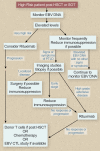How I treat EBV lymphoproliferation
- PMID: 19724053
- PMCID: PMC2774540
- DOI: 10.1182/blood-2009-07-143545
How I treat EBV lymphoproliferation
Abstract
Epstein-Barr virus (EBV)-associated B-cell lymphoproliferation is a life-threatening complication after hematopoietic stem cell or solid organ transplantation resulting from outgrowth of EBV-infected B cells that would normally be controlled by EBV-cytotoxic T cells. During the past decade, early detection strategies, such as serial measurement of EBV-DNA load in peripheral blood samples, have helped to identify high-risk patients and to diagnose early lymphoproliferation. Treatment options include manipulation of the balance between outgrowing EBV-infected B cells and the EBV cytotoxic T lymphocyte response and targeting the B cells with monoclonal antibodies or chemotherapy. Major challenges remain for defining indications for preemptive therapies and integrating novel and conventional therapies.
Figures


References
-
- Cohen JI. Epstein-Barr virus infection. N Engl J Med. 2000;343(7):481–492. - PubMed
-
- Hislop AD, Taylor GS, Sauce D, Rickinson AB. Cellular responses to viral infection in humans: lessons from Epstein-Barr virus. Annu Rev Immunol. 2007;25:587–617. - PubMed
-
- Yang J, Lemas VM, Flinn IW, Krone C, Ambinder RF. Application of the ELISPOT assay to the characterization of CD8(+) responses to Epstein-Barr virus antigens. Blood. 2000;95(1):241–248. - PubMed
-
- Thorley-Lawson DA, Gross A. Persistence of the Epstein-Barr virus and the origins of associated lymphomas. N Engl J Med. 2004;350(13):1328–1337. - PubMed
Publication types
MeSH terms
Substances
Grants and funding
LinkOut - more resources
Full Text Sources
Other Literature Sources
Miscellaneous

